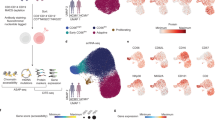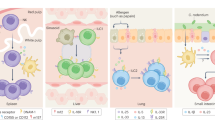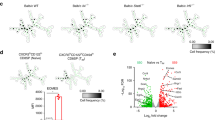Abstract
Clonal expansion and immunological memory are hallmark features of the mammalian adaptive immune response and essential for prolonged host control of pathogens. Recent work demonstrates that natural killer (NK) cells of the innate immune system also exhibit these adaptive traits during infection. Here we demonstrate that differentiating and ‘memory’ NK cells possess distinct chromatin accessibility states and that their epigenetic profiles reveal a ‘poised’ regulatory program at the memory stage. Furthermore, we elucidate how individual STAT transcription factors differentially control epigenetic and transcriptional states early during infection. Finally, concurrent chromatin profiling of the canonical CD8+ T cell response against the same infection demonstrated parallel and distinct epigenetic signatures defining NK cells and CD8+ T cells. Overall, our study reveals the dynamic nature of epigenetic modifications during the generation of innate and adaptive lymphocyte memory.
This is a preview of subscription content, access via your institution
Access options
Access Nature and 54 other Nature Portfolio journals
Get Nature+, our best-value online-access subscription
$29.99 / 30 days
cancel any time
Subscribe to this journal
Receive 12 print issues and online access
$209.00 per year
only $17.42 per issue
Buy this article
- Purchase on Springer Link
- Instant access to full article PDF
Prices may be subject to local taxes which are calculated during checkout






Similar content being viewed by others
References
Sun, J. C. & Lanier, L. L. NK cell development, homeostasis and function: parallels with CD8+ T cells. Nat. Rev. Immunol. 11, 645–657 (2011).
Vivier, E. et al. Innate or adaptive immunity? The example of natural killer cells. Science 331, 44–49 (2011).
Arase, H., Mocarski, E. S., Campbell, A. E., Hill, A. B. & Lanier, L. L. Direct recognition of cytomegalovirus by activating and inhibitory NK cell receptors. Science 296, 1323–1326 (2002).
Smith, H. R. et al. Recognition of a virus-encoded ligand by a natural killer cell activation receptor. Proc. Natl Acad. Sci. USA 99, 8826–8831 (2002).
Dokun, A. O. et al. Specific and nonspecific NK cell activation during virus infection. Nat. Immunol. 2, 951–956 (2001).
Daniels, K. A. et al. Murine cytomegalovirus is regulated by a discrete subset of natural killer cells reactive with monoclonal antibody to Ly49H. J. Exp. Med. 194, 29–44 (2001).
Sun, J. C., Beilke, J. N. & Lanier, L. L. Adaptive immune features of natural killer cells. Nature 457, 557–561 (2009).
Bezman, N. A. et al. Molecular definition of the identity and activation of natural killer cells. Nat. Immunol. 13, 1000–1009 (2012).
Buenrostro, J. D., Giresi, P. G., Zaba, L. C., Chang, H. Y. & Greenleaf, W. J. Transposition of native chromatin for fast and sensitive epigenomic profiling of open chromatin, DNA-binding proteins and nucleosome position. Nat. Methods 10, 1213–1218 (2013).
Kaech, S. M., Hemby, S., Kersh, E. & Ahmed, R. Molecular and functional profiling of memory CD8 T cell differentiation. Cell 111, 837–851 (2002).
Madera, S. et al. Type I IFN promotes NK cell expansion during viral infection by protecting NK cells against fratricide. J. Exp. Med. 213, 225–233 (2016).
Tassi, I. et al. NK cell-activating receptors require PKC-theta for sustained signaling, transcriptional activation, and IFN-gamma secretion. Blood 112, 4109–4116 (2008).
Brand, A. et al. LDHA-associated lactic acid production blunts tumor immunosurveillance by T and NK Cells. Cell Metab. 24, 657–671 (2016).
Freund-Brown, J. et al. Cutting edge: murine NK cells degranulate and retain cytotoxic function without store-operated calcium entry. J. Immunol. 199, 1973–1978 (2017).
Andrews, D. M., Scalzo, A. A., Yokoyama, W. M., Smyth, M. J. & Degli-Esposti, M. A. Functional interactions between dendritic cells and NK cells during viral infection. Nat. Immunol. 4, 175–181 (2003).
Sun, J. C. et al. Proinflammatory cytokine signaling required for the generation of natural killer cell memory. J. Exp. Med. 209, 947–954 (2012).
García-Sastre, A. & Biron, C. A. Type 1 interferons and the virus-host relationship: a lesson in détente. Science 312, 879–882 (2006).
Rapp, M. et al. Core-binding factor β and Runx transcription factors promote adaptive natural killer cell responses. Sci. Immunol. 2, eaan3796 (2017).
Nguyen, K. B. et al. Interferon alpha/beta-mediated inhibition and promotion of interferon gamma: STAT1 resolves a paradox. Nat. Immunol. 1, 70–76 (2000).
Gil, M. P. et al. Regulating type 1 IFN effects in CD8 T cells during viral infections: changing STAT4 and STAT1 expression for function. Blood 120, 3718–3728 (2012).
Madera, S. & Sun, J. C. Cutting edge: stage-specific requirement of IL-18 for antiviral NK cell expansion. J. Immunol. 194, 1408–1412 (2015).
Pauken, K. E. et al. Epigenetic stability of exhausted T cells limits durability of reinvigoration by PD-1 blockade. Science 354, 1160–1165 (2016).
Sen, D. R. et al. The epigenetic landscape of T cell exhaustion. Science 354, 1165–1169 (2016).
Scott-Browne, J. P. et al. Dynamic changes in chromatin accessibility occur in CD8+ T cells responding to viral infection. Immunity 45, 1327–1340 (2016).
Yu, B. et al. Epigenetic landscapes reveal transcription factors that regulate CD8+ T cell differentiation. Nat. Immunol. 18, 573–582 (2017).
Ghoneim, H. E. et al. De novo epigenetic programs inhibit PD-1 blockade-mediated T cell rejuvenation. Cell 170, 142–157.e19 (2017).
Philip, M. et al. Chromatin states define tumour-specific T cell dysfunction and reprogramming. Nature 545, 452–456 (2017).
Zhou, X. et al. Differentiation and persistence of memory CD8(+) T cells depend on T cell factor 1. Immunity 33, 229–240 (2010).
Dominguez, C. X. et al. The transcription factors ZEB2 and T-bet cooperate to program cytotoxic T cell terminal differentiation in response to LCMV viral infection. J. Exp. Med. 212, 2041–2056 (2015).
Omilusik, K. D. et al. Transcriptional repressor ZEB2 promotes terminal differentiation of CD8+ effector and memory T cell populations during infection. J. Exp. Med. 212, 2027–2039 (2015).
Roychoudhuri, R. et al. BACH2 regulates CD8(+) T cell differentiation by controlling access of AP-1 factors to enhancers. Nat. Immunol. 17, 851–860 (2016).
Smith-Garvin, J. E., Koretzky, G. A. & Jordan, M. S. T cell activation. Annu. Rev. Immunol. 27, 591–619 (2009).
González, A. J., Setty, M. & Leslie, C. S. Early enhancer establishment and regulatory locus complexity shape transcriptional programs in hematopoietic differentiation. Nat. Genet. 47, 1249–1259 (2015).
Shih, H. Y. et al. Developmental acquisition of regulomes underlies innate lymphoid cell functionality. Cell 165, 1120–1133 (2016).
Corces, M. R. et al. Lineage-specific and single-cell chromatin accessibility charts human hematopoiesis and leukemia evolution. Nat. Genet. 48, 1193–1203 (2016).
Weber, B. N. et al. A critical role for TCF-1 in T-lineage specification and differentiation. Nature 476, 63–68 (2011).
Germar, K. et al. T-cell factor 1 is a gatekeeper for T-cell specification in response to Notch signaling. Proc. Natl Acad. Sci. USA 108, 20060–20065 (2011).
Xing, S. et al. Tcf1 and Lef1 transcription factors establish CD8(+) T cell identity through intrinsic HDAC activity. Nat. Immunol. 17, 695–703 (2016).
Yang, Q. et al. TCF-1 upregulation identifies early innate lymphoid progenitors in the bone marrow. Nat. Immunol. 16, 1044–1050 (2015).
Jeevan-Raj, B. et al. The transcription factor Tcf1 contributes to normal NK cell development and function by limiting the expression of granzymes. Cell Rep. 20, 613–626 (2017).
Johnson, J. L. et al. Lineage-determining transcription factor TCF-1 initiates the epigenetic identity of T cells. Immunity 48, 243–257.e10 (2018).
O’Shea, J. J. et al. The JAK-STAT pathway: impact on human disease and therapeutic intervention. Annu. Rev. Med. 66, 311–328 (2015).
Villarino, A. V., Kanno, Y. & O’Shea, J. J. Mechanisms and consequences of Jak-STAT signaling in the immune system. Nat. Immunol. 18, 374–384 (2017).
Hartman, S. E. et al. Global changes in STAT target selection and transcription regulation upon interferon treatments. Genes Dev. 19, 2953–2968 (2005).
Kaplan, M. H., Sun, Y. L., Hoey, T. & Grusby, M. J. Impaired IL-12 responses and enhanced development of Th2 cells in Stat4-deficient mice. Nature 382, 174–177 (1996).
Meraz, M. A. et al. Targeted disruption of the Stat1 gene in mice reveals unexpected physiologic specificity in the JAK-STAT signaling pathway. Cell 84, 431–442 (1996).
Fodil-Cornu, N. et al. Ly49h-deficient C57BL/6 mice: a new mouse cytomegalovirus-susceptible model remains resistant to unrelated pathogens controlled by the NK gene complex. J. Immunol. 181, 6394–6405 (2008).
Zheng, Y. et al. Genome-wide analysis of Foxp3 target genes in developing and mature regulatory T cells. Nature 445, 936–940 (2007).
Beaulieu, A. M., Zawislak, C. L., Nakayama, T. & Sun, J. C. The transcription factor Zbtb32 controls the proliferative burst of virus-specific natural killer cells responding to infection. Nat. Immunol. 15, 546–553 (2014).
Bolger, A. M., Lohse, M. & Usadel, B. Trimmomatic: a flexible trimmer for Illumina sequence data. Bioinformatics 30, 2114–2120 (2014).
Langmead, B. & Salzberg, S. L. Fast gapped-read alignment with Bowtie 2. Nat. Methods 9, 357–359 (2012).
Lawrence, M. et al. Software for computing and annotating genomic ranges. PLOS Comput. Biol. 9, e1003118 (2013).
Love, M. I., Huber, W. & Anders, S. Moderated estimation of fold change and dispersion for RNA-seq data with DESeq2. Genome Biol. 15, 550 (2014).
Zhang, Y. et al. Model-based analysis of ChIP-Seq (MACS). Genome Biol. 9, R137 (2008).
Li, Q. H., Brown, J. B., Huang, H. Y. & Bickel, P. J. Measuring reproducibility of high-throughput experiments. Ann. Appl. Stat. 5, 1752–1779 (2011).
Zhu, L. J. et al. ChIPpeakAnno: a Bioconductor package to annotate ChIP-seq and ChIP-chip data. BMC Bioinforma. 11, 237 (2010).
McLean, C. Y. et al. GREAT improves functional interpretation of cis-regulatory regions. Nat. Biotechnol. 28, 495–501 (2010).
Bray, N. L., Pimentel, H., Melsted, P. & Pachter, L. Near-optimal probabilistic RNA-seq quantification. Nat. Biotechnol. 34, 525–527 (2016).
Heinz, S. et al. Simple combinations of lineage-determining transcription factors prime cis-regulatory elements required for macrophage and B cell identities. Mol. Cell 38, 576–589 (2010).
Quinlan, A. R. & Hall, I. M. BEDTools: a flexible suite of utilities for comparing genomic features. Bioinformatics 26, 841–842 (2010).
Acknowledgements
We thank members of the Sun laboratory for comments, discussions, technical support, and experimental assistance. We thank S. Chhangawala, L. Fairchild, and C. Krishna for discussions and technical support. The Integrated Genomics Operation Core was supported by Cycle for Survival and the Marie-Josée and Henry R. Kravis Center for Molecular Oncology. C.M.L. was supported by a T32 award from the NIH (CA009149). N.M.A. was supported by a Medical Scientist Training Program grant from the National Institute of General Medical Sciences of the NIH under award number T32GM007739 to the Weill Cornell/Rockefeller/Sloan-Kettering Tri-Institutional MD-PhD Program and an F30 Predoctoral Fellowship from the NIH National Institute of Allergy and Infectious Diseases (F30 AI136239). M.R. was supported by a fellowship from the German Academic Exchange Service (DAAD; Germany). C.S.L. was supported by NIH grant U01 HG007893. J.C.S. was supported by the Ludwig Center for Cancer Immunotherapy, the Burroughs Wellcome Fund, the American Cancer Society, and grants from the NIH (AI100874, AI130043, and P30CA008748).
Author information
Authors and Affiliations
Contributions
C.M.L. and J.C.S. designed the study. N.M.A., C.D.G., O.-E.W., and M.R. performed the experiments. C.M.L. performed the bioinformatic analyses. C.S.L. and Y. P. consulted on the bioinformatic analyses. C.M.L. and J.C.S. wrote the manuscript.
Corresponding author
Ethics declarations
Competing interests
The authors declare no competing interests.
Additional information
Publisher's note: Springer Nature remains neutral with regard to jurisdictional claims in published maps and institutional affiliations.
Integrated supplementary information
Supplementary Figure 1 Differential chromatin accessibility in NK cells responding against MCMV infection.
(A) Representative gating strategy of Ly49H+ NK cells from wild-type/adoptive transfer recipients for RNA-seq and ATAC-seq datasets. Numbers indicate relative frequencies within shown plots. Red boxes contain sorted populations. (B) Fragment length distribution of individual ATAC-seq samples of Ly49H+ NK cells from wild-type/adoptive transfer recipients. (C) Number of all differentially accessible (DA) regions that either gain (red) or lose (blue) accessibility at indicated transition time points, categorized by magnitude of log2 fold change (FC). (D) Dot-plot ranked by increasing mean normalized log2 counts of accessible regions. Color of dots represents peak type. (E) Peak-centered heatmaps of all high FC differentially accessible (DA) regions (FDR < 0.05; absolute log2FC > 1) during MCMV infection hierarchically clustered on mean-centered normalized log2 counts of peak regions, with stable and transient clusters as indicated. Percentages within boxes show proportion of peaks within each cluster that show a high FC difference between d0 and d35. Clusters that showed > 75% were designated as stable. (F) Heatmap of –log10 raw binomial P-values as calculated by GREAT. Shown are the top 10% most enriched pathways (FDR < 0.05, ranked by binomial P-value) within each cluster, after filtering for pathways that showed more than 10 gene hits.
Supplementary Figure 2 Cell-sorting strategy and quality assessment of ATAC-seq libraries of STAT-deficient NK cells during MCMV infection.
(A) Schematic of NK cell response to primary MCMV infection in Stat1–/– and Stat4–/– NK cells. (B) Representative gating strategy of Ly49H+ NK cells from infected STAT-deficient mixed bone marrow chimeras for RNA-seq and ATAC-seq datasets. Numbers indicate relative frequencies within shown plots. Red boxes contain sorted populations. (C) Fragment length distribution of individual ATAC-seq samples of Ly49H+ NK cells from STAT-deficient mixed bone marrow chimeras.
Supplementary Figure 3 STAT4 and STAT1 differentially promote remodeling of chromatin in activated NK cells.
(A) Frequency polygon of log2 fold changes from differentially accessible (DA) regions (FDR < 0.05) comparing STAT-deficient NK cells to WT cells two days post infection. Counts have a bin width of 0.2. (B) Heatmap of log2 fold changes of gene expression comparing with Stat4–/– or Stat1–/– to WT two days post infection. Shown are genes that are commonly differentially expressed (FDR < 0.05) in both conditions. (C) Bar plots of RNA-seq normalized counts of all STAT family genes in both uninfected and infected NK cells in Stat4–/–:WT (blue) or Stat1–/–:WT (green) two days post infection. Data represent mean ± s.d; *padj < 0.05 as calculated by DESeq2. (D) Pairwise overlap of ChIP-seq, RNA-seq, and ATAC-seq results. P-values were calculated by hypergeometric tests using all annotated genes for “common genes” tests and a union of accessible and occupied peaks for “common peaks” tests. (E) Differential expression (FDR < 0.05) of overlapping genes indicated in Fig. 3e from Stat1–/–:WT NK cells two days post infection. (F) Genomic tracks of aligned STAT1-ChIP-seq and Stat1–/–:WT ATAC-seq data. y-axis depicts normalized counts, while x-axis displays genomic axis with scale bar. Bar plots quantify number of reads within highlighted peak regions (dashed lines) shown as mean ± s.d.
Supplementary Figure 4 ISRE, TCF–LEF, and NFκB regions are enriched within differentially accessible chromatin regions in memory NK cells.
(A) MA plot shows normalized mean values on x-axis and log2 fold change on y-axis. Horizontal lines indicate log2 fold change of + /- 0.5 and + /- 1, with numbers on the right indicating the total number of differentially accessible (DA) regions (FDR < 0.05) within each section. (B) Boxplots of log2-transformed normalized reads overlapping the center of all instances of indicated motifs found in filtered differentially accessible (DA) regions. P-values were calculated using two-sided Wilcoxon signed-rank test. (C) Metacoverage of DA median normalized tag counts surrounding known motif regions listed, found among all filtered DA regions. (D) Venn diagrams of overlap between de novo and known motif instances among filtered DA regions. P-values are calculated by hypergeometric test, using all filtered DA regions described in Fig. 4a as background. (E) Gene expression in naïve NK cells from RNA-seq data of indicated genes plotted as log2 transcripts-per-million (TPM) plus pseudocount of 1 shown as mean ± s.d. Dashed line shows count of 1. (F) Gene expression from RNA-seq data of indicated genes plotted as normalized log2 counts. Line represents mean.
Supplementary Figure 5 Cell-sorting strategy and quality assessment of ATAC-seq libraries of CD8+ T cell during MCMV infection.
(A) Representative gating strategy of MCMV-specific (m45+) CD8+ T cells from infected wild-type hosts for RNA-seq and ATAC-seq datasets. Numbers indicate relative frequencies within shown plots. Red boxes contain sorted populations. (B) Fragment length distribution of individual ATAC-seq samples of naïve or m45+ CD8+ T cells from infected wild-type hosts.
Supplementary Figure 6 Distinct and shared chromatin accessibility profiles of NK cells and CD8+ T cells during viral infection.
(A) Heatmap of all atlas peaks in NK and CD8+ T cells, including peaks that are unique to NK cells, unique to CD8+ T cells, and common between the two. (B) Principal component analysis of ATAC-seq on all common atlas peaks between NK cells and CD8+ T-cells. Normalized log2 values were used for plotting. (C) Tabulation of differentially accessible (DA; FDR < 0.05; absolute log2 fold change > 0.5; left) common atlas peak regions and differentially expressed (DE; FDR < 0.05; absolute log2 fold change > 1; right) genes within categories defined by comparing memory and naïve cell states in both NK cells and CD8+ T cells. Common DA or DE regions are highlighted in gray. (D) Heatmap of DA atlas peaks in NK and CD8+ T cells, split by categories defined in (C). (E) Heatmap of DE genes in NK and CD8+ T cells, split by categories defined in (C). (F) Venn diagram of overlap between common DA gene loci (ATAC) and DE genes (RNA). P-values are calculated by hypergeometric test, using a union of all expressed genes and common atlas-assigned genes as background. (G) Gene expression from RNA-seq data of AP-1 transcription factor family genes plotted as log2 transcripts-per-million (TPM) plus pseudocount of 1 shown as mean ± s.d. Dashed line shows count of 1. Gapdh and Cd4 are plotted as positive and negative controls, respectively.
Supplementary information
Supplementary Figures
Supplementary Figures 1–6
Rights and permissions
About this article
Cite this article
Lau, C.M., Adams, N.M., Geary, C.D. et al. Epigenetic control of innate and adaptive immune memory. Nat Immunol 19, 963–972 (2018). https://doi.org/10.1038/s41590-018-0176-1
Received:
Accepted:
Published:
Issue Date:
DOI: https://doi.org/10.1038/s41590-018-0176-1
This article is cited by
-
Memory B cell subsets have divergent developmental origins that are coupled to distinct imprinted epigenetic states
Nature Immunology (2024)
-
Control of nutrient uptake by IRF4 orchestrates innate immune memory
Nature Immunology (2023)
-
Cardinal features of immune memory in innate lymphocytes
Nature Immunology (2023)
-
Remembering foods and foes: emerging principles of transcriptional memory
Cell Death & Differentiation (2023)
-
Themis2 regulates natural killer cell memory function and formation
Nature Communications (2023)



